Results 421 to 430 of 12096
Thread: Anandtech News
-
04-21-11, 01:50 PM #421
Anandtech: The Motorola Xoom Giveaway, Round 3
When we reviewed Motorola's Xoom, all that was available was the $799 3G version. Since then Motorola has released a more affordable $599 WiFi only edition with 32GB of NAND on board. Inside the Xoom, as you're all familiar with is NVIDIA's Tegra 2 SoC. Tegra 2 was Google's reference SoC for the Honeycomb release of Android, and thus it's been the heart and soul of all recently announced Honeycomb tablets.
NVIDIA, eager to parade its success with Tegra 2, shipped me a box containing four WiFi Motorola Xooms to give away to our most loyal readers. We're still trying to contact the winner of the first Xoom (AyashiKaibutsu). The second Xoom goes to AnandTech reader jrtroo, respond to my email to claim your prize! Remember you have seven days to claim your prize otherwise you forefit it. Also remember that the contest is only available to legal residents of the United States (excluding Puerto Rico). Be sure to read the eligibility section to make sure you aren't disqualified if you win!
Here's a shot of the remaining two:
We'll be giving one away every two days until we're out of WiFi Xooms. Sound like a plan?
Read on for instructions on how to win!
More...
-
04-22-11, 01:10 PM #422
Anandtech: Nettop and Mini-ITX Buyer’s Guide
Most of our Buyer's Guides focus on full desktop builds, but what about something a little smaller? Perhaps you're looking for an inexpensive yet sufficiently powerful system to function as an HTPC, or maybe you want a low power device so you can cut down a bit on power bills. Whatever the reason, if you're interested in building a mini-ITX system or a nettop we've got several takes on the concept to discuss.
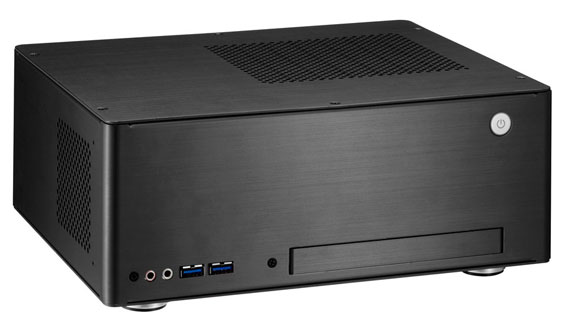
More...
-
04-25-11, 06:41 AM #423
Anandtech: Lenovo X1 Leaked: Sandy Bridge Gets Thin
Lenovo is taking another swing at the MacBook Air. Having discontinued their X300 ultraportable line, Lenovo seemed content to compete at the 11" and 12" form factor, without sitting a horse at the popular but Air dominated 13.3" form factor. But a listing on a German computer distributor's site leaked and documents released on the Lenovo channel distributors' site confirmed that the ThinkPad purveyor is planning to take on the Air with a 21.5 mm thick ultraportable notebook called the X1.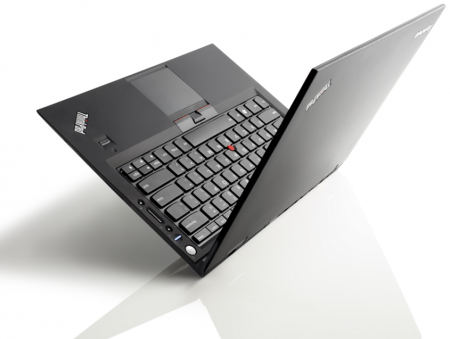
While not quite as thin as the much hailed MBA, the X1 packs impressive specifications, especially for a device targeted at those of us used to sacrificing performance for lightweight. Headlining the device is a 2.5GHz Core i5-2520M CPU, the same processor as can be found in the 34.6 mm thick X220. Let me say that again, Lenovo managed to grow the screen and pack the same processor into a device one third less thick. A 13.3" 1366 x 768 Gorilla Glass screen, 160GB SSD, 8GB of RAM, an SDXC card reader and the excellent keyboard and build quality we've come to expect from the ThinkPad line round out the specifications. But that's not all.
Earlier today, Lenovo released slides from a distribution webinar that reveals that the X1 will sport a new type of battery which promise significant improvements in stamina and charging speed. Lenovo claims an 80% charge in just 30 plugged in minutes, for the sealed battery. This battery technology is expected to be included in all their future ultraportable notebooks including the previously announced Edge 220s and 420s, and the X1 is rated at 5 hours of use between charges. And there's one more thing.

In the same slide discussing the new warranty policies regarding these new batteries, Lenovo reveals that the battery tech will be included in the X Slate - presumably Lenovo's upcoming Honeycomb based tablet offering.
More...
-
-
04-26-11, 12:10 AM #425
Anandtech: Dell's New Mobile Workstations: These Are The Laptops You're Looking For
Having had the chance to check out Toshiba's and HP's impending enterprise-class notebooks, more and more I'm convinced spending up is the way to go when it comes to buying a notebook that both looks and feels like quality. While Dell's Precision notebooks are still a little boxy and aren't quite the ladykillers the new HP EliteBooks are, there's still something very austere and functional about them that puts consumer-grade laptops from any manufacturer to shame. If you're one of the people that didn't much care for Dell's new XPS line, these may be for you.
Dell has announced two new mobile workstations, the Precision M4600 and M6600, 15.6" and 17.3" respectively. Both are based on Intel's Sandy Bridge platform, supporting up to 32GB of DDR3-1333 (16GB of DDR3-1600) in four DIMM slots along with ramping all the way up to the 55-watt Core i7-2920XM, and each offers a range of choices from AMD's FirePro Mobility GPUs and NVIDIA's Quadro GPUs. Best of all, Dell is offering bare-minimum 72% gamut displays on each of these notebooks along with an optional upgrade to an IPS RGB-LED display on the M4600. Let's break them down.
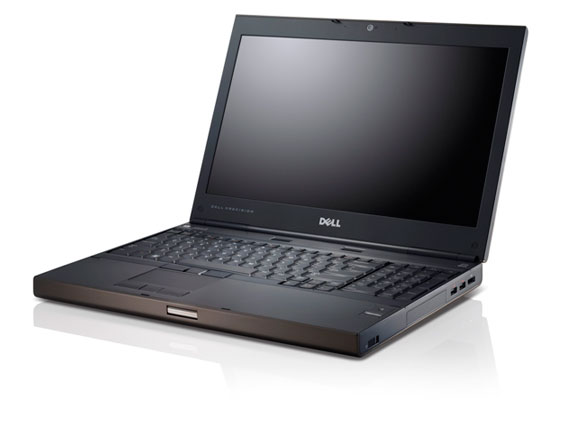
The 15.6" Precision M4600's screen options start from a basic 1366x768 screen, move up to a multi-touch enabled 1366x768 screen, then on to a 1080p screen, and then finally Dell's PremierColor IPS RGB-LED backlit 1080p screen. GPU options include the AMD FirePro M5950 Mobility Pro with 1GB of GDDR5 (GPU equivalent to the 480-shader Radeon HD 6670), the NVIDIA Quadro 1000M with 2GB of GDDR3 (GPU equivalent to the 96-core GeForce GT 540M, depending on the clocks), and the NVIDIA Quadro 200M with 2GB of GDDR3 (GPU equivalent to the 192-core GeForce GTX 460M, but without GDDR5 and only a 128-bit memory interface). Additionally, the M4600 can be configured with a 128GB SSD mini-card to supplement the hard drive; two 128GB SSDs can be configured to run in RAID 0 or RAID 1. It offers virtually every type of connectivity under the sun: gigabit ethernet, 802.11n, Bluetooth 3.0, WWAN, 2x USB 2.0, 2x USB 3.0, FireWire, eSATA, HDMI, DisplayPort, VGA, ExpressCard/54, and a SmartCard reader. The M4600 starts at $1,678 and will be available on May 10th.
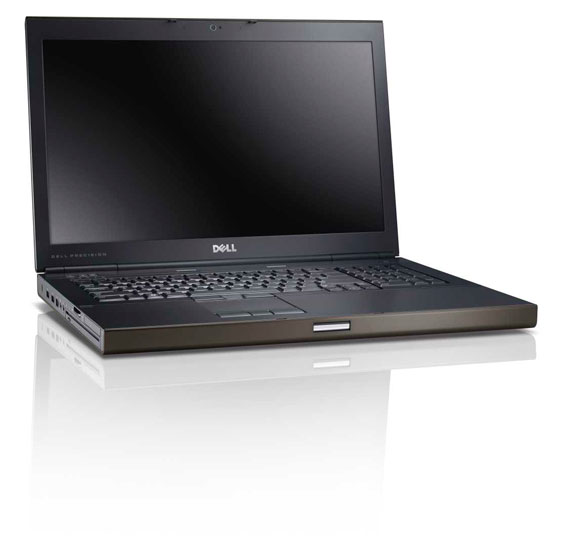
Moving up to the Papa Bear, the 17.3" Precision M6600 brings to bear all of the same processor options and connectivity as the M4600, but graphics, display, and storage options are improved. This time, the display starts at a basic 1600x900 panel, but can be upgraded to a 1080p display with or without multi-touch capability. It won't be launching with an IPS display option, but Dell expects availability soon after. Graphics get a boost as well, allowing the following: the AMD FirePro M8900 Mobility Pro with 2GB of GDDR5 (GPU equivalent to the 960-shader Radeon HD 6970M), the NVIDIA Quadro 3000M with 2GB of GDDR5 (240 cores, likely using a GF106/GF116 die, which means roughly GTX 470M with more bandwidth but fewer cores), the NVIDIA Quadro 4000M with 2GB of GDDR5 (336 cores, again with a GF106/GF116 core, but now surpassing GTX 470M), and topping out at the NVIDIA Quadro 5010M with a whopping 4GB of GDDR5 (a full 384 cores, a full-fledged GF104/GF114, matching up with the GTX 485M). Besides the graphics and processor choices, the M6600 adds a second 2.5" drive bay to go alongside the first bay and the offered 128GB mini-card SSD, and these three can be configured together into RAID 0, RAID 1, or even RAID 5. The M6600 starts at $2,158 and will be available on May 10th.

Besides these two notebooks, Dell is offering the Precision R5500 rackmount workstation. This monster is capable of supporting up to five full-length, full-height PCIe x16 cards, dual graphics cards, up to 192GB of memory, up to five SATA drives and six SAS drives, and runs one or two Xeon 5600 series processors. These chips are still based on Westmere technology as opposed to Sandy Bridge, but combined can allow for a total of twelve physical cores and twenty-four logical cores. The R5500 starts at $2,551 and will be available in the states and Europe on May 3rd, showing up in the Asia-Pacific region a week later on the 10th.
More...
-
04-26-11, 12:00 PM #426
Anandtech: Additional Details on Sandy Bridge-E Processors, X79, and LGA2011
The latest Intel roadmap has come out, and there are plenty of interesting bits of information to sift through. We’ll be looking at other areas over the coming days, but today we’re going to start with the Sandy Bridge-E (SNB-E) processors. Sporting a new socket and chipset, the SNB-E CPUs will start showing up in Q4 this year. None of this is new, as we’ve known the general timeframe for the launch since our Sandy Bridge review, but we can now add some concrete specs. According to the roadmap, the initial SNB-E lineup will consist of three CPUs: two hex-core processors and one quad-core. We don’t have model numbers yet, but we do have most of the other pieces of information.
The Sandy Bridge-E Lineup Family Core i7 Extreme Core i7 Core i7 Core/Thread Count 6/12 6/12 4/8 Frequency 3.3GHz 3.2GHz 3.6GHz Max SC Turbo 3.9GHz 3.8GHz 3.9GHz L3 Cache 15MB 12MB 10MB Overclocking Fully unlocked Fully unlocked Limited unlock The new chips will all use the LGA2011 socket with Intel’s X79 chipset, scheduled for simultaneous release with the CPUs. The platform replaces the current LGA1366 with X58 chipset, providing an upgrade path for high-end enthusiasts and workstation users. Memory support will move up to quad-channel DDR3-1333, so where the current Bloomfield can provide up to 25.6GB/s of bandwidth at the specified tri-channel DDR3-1066, LGA2011 kicks that figure up to 42.7GB/s—a 66% increase. The additional memory bandwidth should be particularly useful with certain workloads on the hex-core chips.
One interesting piece of information is that the roadmaps make no mention of integrated graphics or Quick Sync, suggesting the platform will be for discrete graphics only. That makes perfect sense on one level, as users likely to upgrade to such high-end systems are almost sure to have discrete GPUs. On the other hand, Quick Sync has proven very effective for video transcoding, providing up to a four-fold increase over CPU-based encoding, so the loss of the feature is unfortunate.
Intel hasn’t disclosed all of the various Turbo modes yet, but they have listed the maximum single-core Turbo speeds. Both the hex-core 3.3GHz and quad-core 3.6GHz top out at a maximum speed of 3.9GHz, and likely the hex-core chip can do 3.6GHz on QC workloads making it equal to or better than the QC chip on every potential workload. The 3.2GHz hex-core steps the maximum clocks speeds down 100MHz, along with cutting the L3 cache size. As with other i7 processors, all the new chips support Hyper-Threading, and while the hex-core chips will be fully multiplier unlocked the quad-core offering will be a “limited unlock”. The roadmap states that the limited unlock will allow up to six bins of overclocking above the maximum Turbo frequencies, which means that even that chip should be able to hit up to 4.5GHz (with appropriate cooling, motherboard, etc.)
Intel makes no mention of pricing at this time, but the new chips should follow familiar patterns. The i7 Extreme will replace the current i7-990X and target the familiar $1000 price point. Moving down, the 3.2GHz hex-core replaces the current i7-980 (which is set to replace the i7-970 in the near future), taking over the $550~$600 range. At the bottom of the SNB-E lineup is the quad-core 3.6GHz chip, which will take over from the i7-960 as well as providing a competitor to the i7-2600 in the sub-$300 market.
One final item of note is that while the X79 chipset will include native support for SATA 6Gbps (up to 10 ports, with four additional SATA 3Gbps ports), USB 3.0 support is still missing, similar to the current 6-series chipsets. X79 natively supports dual x16 PCIe graphics, or quad x8 graphics, along with another extra that we haven’t seen before. The chipset has the option to use four additional PCIe lanes from the PCH dedicated to storage bandwidth, presumably to help with performance on fast SATA 6Gbps devices (e.g. SSDs). Assuming LGA2011 uses a similar 25.6GBps QPI link to the X79 chipset, we’re not quite sure why these extra lanes are necessary, but perhaps configurations that utilize all 10 SATA 6Gbps ports with fast SSDs will see a performance boost. It’s also possible that these storage-dedicated lanes are in addition to the existing QPI and memory connections, as it’s otherwise difficult to account for all the added pins over LGA1366.
That wraps up the consumer side of the SNB-E platform. Note that Intel will also have SNB-E Xeons launching in a similar timeframe. The bigger concern for us is that SNB-E continues the strengths of the Bloomfield/Gulftown processors but doesn’t address some of the weaknesses (i.e. lack of Quick Sync). SNB-E looks like a very capable processor, but if you’re willing to forego the current SNB lineup and wait for SNB-E, you’ll then have to contend with Ivy Bridge. That will be Intel’s first 22nm CPU and it’s scheduled for release in the first half of 2012, but that’s a story for a separate article. We’ll also have additional information on Atom CPUs and Intel SSDs in the near future.
More...
-
04-26-11, 01:10 PM #427
Anandtech: This Just In: HTC Droid Incredible 2 on Verizon
This morning HTC and Verizon announced the Droid Incredible 2 (aka Incredible S) will be up for sale starting on April 28, this Thursday, for $200 with a 2-year contract. Internally the Droid Incredible 2 uses the same Qualcomm MSM8655 Snapdragon SoC we've seen in other recent releases, including the HTC Thunderbolt. The 8655 combines a single Scorpion core running at 1GHz with an Adreno 205 GPU, all built on a 45nm process. The SoC has 768MB of LPDDR2 DRAM on-package.
We're working on our full review of the phone (it just showed up this morning) but read on for a quick preview!
More...
-
04-26-11, 11:20 PM #428
Anandtech: HTC Thunderbolt Review: The First Verizon 4G LTE Smartphone
We've spent a long time testing Verizon's first 4G LTE enabled smartphone, the HTC Thunderbolt. We're finally ready with the complete review. It's got the fastest cellular connectivity around, and simultaneous voice and data to boot.
Read on for the full review!
More...
-
04-26-11, 11:20 PM #429
Anandtech: Verizon 4G LTE: Two Datacards and a WiFi Hotspot Massively Reviewed
2011 is going to be a year dominated by fourth generation network everything - handsets, portable hotspots, datacards, and news of networks lighting up in each regional market. There’s a veritable soup of wireless network tech being billed as 4G, but far and away the most interesting suite of new network access technology is LTE - Long Term Evolution. We got the chance to play around with a number of Verizon’s upcoming LTE enabled phones and preview the carrier’s two launch LTE datacards at CES. Since then, we’ve spent a considerable amount of time with Verizon’s 4G LTE out in the wild. We’ve split the reviews down the middle - our HTC Thunderbolt review is one piece, everything else LTE is in here, including the Pantech UML290, Verizon USB551L, and Samsung SCH-LC11 WiFi hotspot.
Read on for the full reviews.
More...
-
04-26-11, 11:50 PM #430
Anandtech: NVIDIA Synergy to Bring Optimus to Desktops
We first encountered NVIDIA’s Optimus Technology in February of last year. It has done wonders for laptop battery life on midrange systems, where manufacturers no longer need to worry about killing mobility by including a discrete GPU. Over the past fourteen months, we have seen the number of Optimus enabled laptops balloon from a few initial offerings to well over 50—and very likely more than 100. That sort of uptake is indicative of a successful technology and feature, and while we do encounter the occasional glitch it’s not much worse than the usual driver bugs we deal with.
If you were among those who thought, “This sounds like a great technology—when will they bring it to the desktop?” you’re not alone. So far it has only been available in laptops, and even then we haven’t seen any notebook vendors support the technology with anything faster than a GT 555M (i.e. there are so far no notebooks with GTX GPUs that support Optimus; the closest we get is Alienware’s M17x, which uses their own BinaryGFX switching technology).
Previously, the lack of switchable graphics on desktops—particularly something as elegant as NVIDIA’s Optimus—hasn’t been a big deal. That all changed when Intel released Sandy Bridge and introduced their Quick Sync technology. In our Sandy Bridge review we looked at Quick Sync and found it was the fastest way to transcode videos, providing up to double the performance of an i7-2600K CPU and potentially four times the performance of dual-core SNB processors. Unfortunately, there’s a catch: as we mentioned in our SNB review, Quick Sync works only if the IGP is enabled and has at least one display connected.
This limitation is particularly irksome as the only way you can get the IGP is if you use the H67 chipset (and give up the overclocking and enthusiast features offered by P67). The Z68 chipset should provide both overclocking and IGP support in the near future, but you’re still left with the IGP use requirement, making Quick Sync essentially unavailable to users with discrete GPUs—who are very possibly the most likely candidates for actually making use of the feature.
There appears to be some good news on the horizon. It’s hardly a surprise, as we’ve suspected as much since Optimus first reared its head, but VR-Zone reportsthat NVIDIA is finally bringing the technology to desktops. There’s a name change, as it will now go by the name Synergy (though you may also see it referred to as Desktop Optimus at times). Rumors are that Synergy will see the light of day late next month or in early June.
While it’s true that you can already get access to Quick Sync while using a discrete GPU using Lucid’s Virtu, there are a few differences worth noting. First and foremost, Synergy is software based, free, and requires no license agreement. Any recent NVIDIA GPU (400 or 500 series) should work on H67, H61 or Z68 chipset motherboards. (P67 does not support the SNB IGP and thus won’t work.) You’ll need the appropriate drivers and BIOS (and maybe VBIOS), but that should be it. No special hardware needs to be present on the GPU or motherboard and anyone with the appropriate GPU and motherboard chipset should have the option of using Synergy.
This is in contrast to Virtu, which only comes bundled with certain motherboards and incurs a price premium on those boards. However, Virtu still has the advantage of working with both AMD and NVIDIA GPUs. Owners of AMD GPUs will have to rely on Virtu or wait for AMD to come out with their own equivalent to Virtu and Synergy.
One final note is that both Virtu and Optimus/Synergy function in a similar fashion at a low level. There are profiles for supported games/applications, and when the driver detects a supported executable it will route the API calls to the discrete GPU. Here’s where NVIDIA has a big leg up on Lucid: they’ve been doing Optimus profiles for over a year, and while Lucid now lists support for 157 titles, NVIDIA has a lot more (and the ability to create custom profiles that generally work). You also don’t have to worry about new GPU drivers breaking support with Virtu, as NVIDIA handles all of that in their own drivers.
We’ll certainly be keeping an eye out for Synergy and will report our findings when it becomes available. In the meantime, gamers interested in Quick Sync as well as people looking to cut down on power use when they’re not using their GPU have something to look forward to. Now bring on the Z68 motherboards, Intel.
More...
Thread Information
Users Browsing this Thread
There are currently 19 users browsing this thread. (0 members and 19 guests)






 Quote
Quote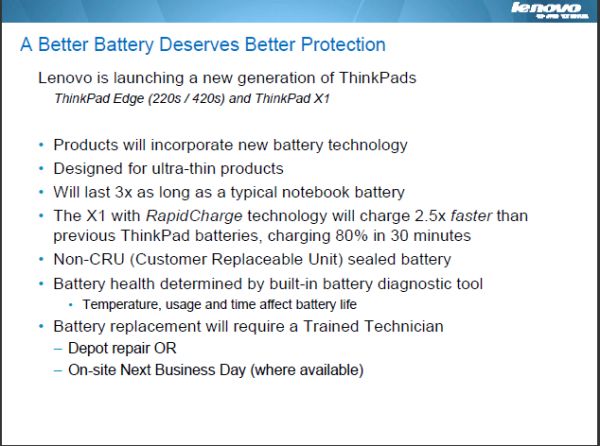



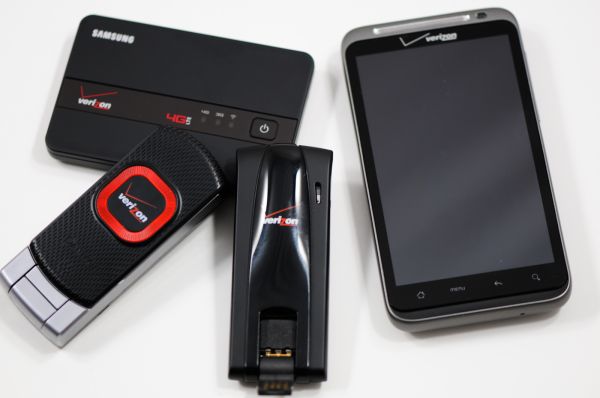
















Bookmarks